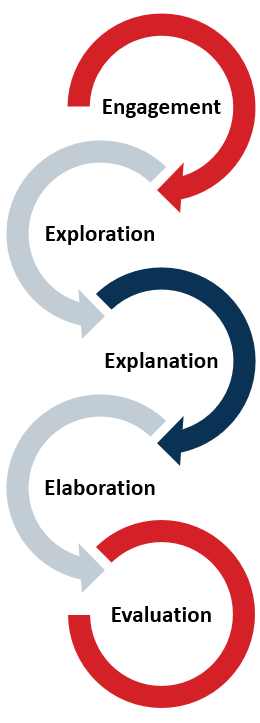
References
- Bybee, R., & Landes, N. M. (1990). Science for life and living: An elementary school science program from Biological Sciences Improvement Study (BSCS). The American Biology Teacher, 52(2), 92-98.
- Héctor Ruiz-Martín & Rodger W. Bybee, 2022, The cognitive principles of learning underlying the 5E Model of Instruction, International Journal of STEM Education volume 9, Article number: 21 (2022)
- Etheredge, S., & Rudnitsky, A. (2003). Introducing students to scientific inquiry: How do we know what we know? New York: Pearson Education.
The 5E Model of Instruction
5E is an instructional model which encompasses the following 5 stages:
Engagement
In the first stage, students are introduced to the new concept through short activities such as; short games, picture books, videos, or real-world problems. These activities aim at activating learners’ curiosity and stimulating their interest. Also, teachers might use brainstorming techniques, or ask questions to assess students’ prior knowledge of the topic.
Exploration
In the second stage, students explore the new concept through hands-on or mind-on activities that encourage investigation and inquiry. These activities also promote collaboration among learners and enable them to share their experiences to make sense of the topic. In this stage, teachers may act as facilitators of their students’ discussions while watching and listening to their interactions.
Explanation
In the third stage, teachers help students build knowledge about the new concept based on the exploration stage. First, instructors ask students what they learned while exploring the concept and if they have any questions. Afterward, teachers use in-class presentations, images, or recorded videos to share additional information such as key items that the students need to know regarding the new topic. The information given by teachers assists students in making connections between what they have already experienced in the previous stage and the new concept.
Elaboration
In the fourth stage, students have the opportunity to apply what they have learned and thus develop a deeper understanding. Teachers may assign projects such as creating a presentation or conducting further investigations, expecting students to use the vocabulary or the terms they have learned during the explanation stage.
Evaluation
In the fifth stage, teachers assess the students to determine whether they have fully grasped the core concepts. The assessments used are either formal or informal such as; tests, quizzes, observations, projects, and self or peer assessments.
